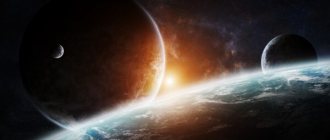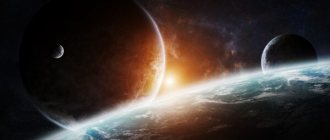Fact No. 1
The Sun is the Solar System as a whole. How can this be, because the system that is part of the galaxy is a system of planets, and the Sun is just a star, albeit the most central one. It would seem that the objects are completely different. Still, one has only to look at the Solar System in terms of its mass, and one can immediately see that the Sun occupies 98% of the total mass of the system in which humanity lives. The remaining 2% were divided to one degree or another by the 8 planets in the system, including the Earth. The lion's share of the mass is occupied by Jupiter and Saturn, the so-called “Gas Giants”. The Earth's share of the entire system accounts for an incredibly tiny mass by cosmic standards.
What is the Sun made of?
In terms of its chemical composition, our luminary is no different from other stars and contains: 74.5% hydrogen (by mass), 24.6% helium, less than 1% other substances (nitrogen, oxygen, carbon, nickel, iron, silicon, chromium, magnesium and other substances). Inside the core there are continuous nuclear reactions that convert hydrogen into helium. The absolute majority of the mass of the Solar System - 99.87% belongs to the Sun.
Composition of the Sun
Interesting fact : The Sun has an almost perfect spherical shape. The difference in diameters connecting opposite points of the equator and poles is 10 kilometers. And this despite its gigantic size!
Fact No. 6
The sun is a multi-layered star. The visible surface of a star is only its outer layer. It is called the photosphere. The temperature on it can reach 5700 Kelvin or 15561000C, because one Kelvin is equal to 2730C.
Then, at around 70% of the solar diameter, there is a layer called “convection”. Next is a zone called "Radiant Transfer". The center of the star is the nucleus. Its temperature reaches values of at least 16,000,0000C. It now becomes clear that the solar surface is not the hottest place not only on the star, but also in the solar system as a whole.
Characteristics of the Sun
The sun has the following parameters:
- Age –4.57 billion years;
- Distance to Earth: 149,600,000 km
- Mass: 332,982 Earth masses (1.9891·10³⁰ kg);
- The average density is 1.41 g/cm³ (it increases 100 times from the periphery to the center);
- The orbital speed of the Sun is 217 km/s;
- Rotation speed: 1.997 km/s
- Radius: 695-696 thousand km;
- Temperature: from 5,778 K at the surface to 15,700,000 K at the core;
- Corona temperature: ~1,500,000 K;
- The Sun is stable in its brightness, it is in the 15% of the brightest stars in our Galaxy. It emits less ultraviolet rays, but has more mass compared to similar stars.
Fact No. 7
For centuries, religion refused to acknowledge the rotation of our planet around the sun. Religious leaders and their followers considered our planet to be the center of all things. It got to the point that in 1633, a physicist named Galileo Galilei was condemned for his public support of the system of the universe put forward by Nicolaus Copernicus, who argued that the planet revolved around a star. The church considered this theory to be a theory of heretics since 1616. As a result, Galileo was imprisoned for life. Later, they took pity on him, and life imprisonment was replaced by house arrest, but under the tireless eye of the Inquisition.
The church openly acknowledged that the Earth rotates around the sun in 1992. This was done by none other than the famous John Paul II. The Pope went further and admitted that Galileo's trial was wrong, calling it a "tragic misunderstanding."
Why does the sun shine?
Many philosophers and scientists have tried to answer this seemingly simple question. The ancient Greek astronomer Anaxagoras managed to go to prison for his theory of a red-hot metal ball. Clarity came with the beginning of the 20th century and the discovery of the phenomenon of radioactivity, and then the possibility of conducting controlled nuclear and thermonuclear reactions.
It was these discoveries that lifted the veil of mystery about the origin of the most common natural phenomenon. English scientists Ernest Rutherford and Arthur Eddington were the first to suggest that thermonuclear fusion reactions occur in the depths of our star. Thanks to this, the Sun's hydrogen gradually turns into helium, releasing streams of photons that we observe as light.
Ernest Rutherford
Interesting fact : the color of our star is pure white, due to the passage of layers of the earth’s atmosphere we see it: yellow, red, orange.
Fact No. 10
The existence of life on Earth is impossible without solar heat and light. However, if we imagine that the Sun will stop giving heat, then first of all, in just one week the temperature on the surface of our planet will drop to -180C. Only a year will pass and the surface of the Earth will be stable at -730C. But that’s not all, because the temperature will not stop dropping, which will certainly result in the death of all forms of life on the planet and the onset of permafrost.
Vladimir Soloukhin - The sun was setting in Zhuravlikha
The sun was setting in Zhuravlikha, the distant bushes were going to bed, and the copper crosses were going out in the small and quiet church.
And then from a distant ravine, following a herd of slow cows, the blue of July evenings floated out, dark as mash.
The forest turned black with a jagged edge In the gold of the sunset strip, And the flower left by the bee grew heavy under the drops of dew.
Inviting me to fairy-tale lands, an owl hooted behind the village, and they sent me, a boy, too early to sleep in the hayloft.
I watched, without immediately falling asleep, how a star moved in the crack, how the moon pulled the wires through the holes of the blue barn.
At this hour, usually over the river, Solovyov in the wilderness surroundings, Someone's restless soul was scattered with dashing music.
“Eh, girl, clear dawn, come out to meet me - I’ll love you! Boyfriend, maple club, don’t go to the girl - I’ll ruin you!”
And almost until dawn, excess strength, violence and fire, this slightly intoxicating, menacing accordion reigned over the area.
But one day, somewhere in the distance, Where the sublunar grass sleeps, Quiet, unheard singing began to sound, timid at first,
And then it flowed more solemnly and higher To the sky, to the stars, to the heart... In my life I have heard many violins, And great violins, I had the opportunity.
But I no longer heard such a thing, as if from the moon itself Music arose and, rejoicing, Floated over the quiet land,
The White cherry orchards sounded like a quiet song... And from this audacity at first the formidable frets fell silent.
Well, after that, as soon as evening falls, there is an abundance of strength, violence and fire, A slightly intoxicated, menacing accordion was moving towards a new song.
And, afraid to get closer, she must have walked around in bass voices, And joyful, both of these voices merged into a duel.
The July nights passed, fine, And in the harmony, which had gone astray, Something different appeared, Trembling, almost timid.
The more the violin rejoiced and called, alarming and beckoning. There was a lot of sadness in the songs, There was a lot of power and fire.
And then these sounds fell silent, my debaters fell silent, and then the marvelous nightingales struck in the area with renewed force.
The night twinkled like a blue star, Roosters crowed in the distance. How could I have seen from the hayloft, How the lovers passed through the boundary,
How, protecting from the morning cold, - You know, the soul is really hot - A guy wrapped a girl from the city in his jacket from a hot shoulder.
Fact No. 12
There is no larger object than the Sun in our galactic system. To understand the size of the star, you just have to imagine that if you filled all the space it occupies with planets like the Earth, then the star would accommodate at least 960,000 of them! And this is only if you place spherical planets in the Sun. If oblate variants of planets are placed in the star, 1,300,000 planets similar to the one on which people live will be able to fill the space occupied by the Sun. In terms of area, the surface of the sun is 11,900 times larger compared to the same indicator of the Earth.
Children's poems about the sun
Red-haired greetings
Andrey Eismont Red-haired sun, in the red-haired summer, Redheads gave greetings to everyone! On the red bench there are two red “talkers”. The gray cat has red ears. Redheads have freckles on their noses in summer. The tops of their heads became red from the sun. Red hands, red legs. A red bus is standing by the road. And a red field of dandelions. Red-haired Kirill and red-haired Olya. I'll say hello to Redhead now! If you look in the mirror, you’re a redhead!
I am Sunshine
Arina Stein I am the Sun, I am a ray of heaven, I reign in the endless heights, I am Magic and at night I generously give a wonderful light to my companion the moon. I warm the young shoots, I kiss children sweetly on the crown, and even in days of severe weather I keep you faithful to the white swans. I am Sunshine! - A cure for trouble! I am Sunshine! And there is no one more tender than me! I am the Sun, which means I have the power to Shine for you brighter than a thousand candles!
Like the sun has a lot to do
Valentina Skvortsova The sun moves around in the sky - Now over the forest, now over the meadow, Now over the river and houses, Now it suddenly blinks its eyes, Smiles at someone, Now it caresses, as if It warms, dries, fries the body... Like the sun has a lot to do .
Sun and Shadow
Vera Donskaya The sun set on the fence. The Shadow instantly disappeared. She lay here for a long time! And now she suddenly ran away! The sun was very surprised. Where did she disappear to? And it left a fence. Off to look for the Shadow! The Shadow is looking for the Sun everywhere: Under a bush, in a hole, in a nest, But it just can’t find it. Suddenly the Hedgehog says to the Sun: “You, Sun, are in vain looking for the Shadow. You wasted the whole day. To your question - my answer: Where the Sun is, there is no Shadow!
Give me some ray of light!
Vladimir Gribanovsky Sunshine, sunshine, give me a ray of rays! For me, this gift is the best! If it gets cold, He will warm me up, If it gets sad, He will silently regret it. If darkness comes - He will show me the path, Where is my path - He will whisper to me, he will tell me! Sunshine, sunshine, give me some rays! In life without him, I feel cold and bored...
My friend is the sun
Galina Tomashevskaya
Tell me, who doesn't like the way the sun smiles? How fun and joyful we are from that smile! It is always beautiful in the blue, clear sky! There is light in your window to be friends with you. You think: how difficult and simply impossible for a child to be with the sun, how to be friends with children. It is big, bright, hot and hot, And how can he put candy in his palm? But everything is much simpler: It is with you in the grove, It floats along the river and on the lake in a boat. She roller-skates and tumbles down the hill, and invites you to soak up the hot sand. In the evening the sun will disappear and be covered with clouds, so that adults and children can hurry home! In the morning, they all can’t wait to meet again soon. Both the sun and we like this kind of friendship!
Gift for Marishka
Irina Darnina Our sun has returned, It will shine for everyone now... Everything in the world has shaken up, Open the door, people! Warmth will now flow to us, Give everyone a smile... I love it so much when the Sun laughs and speaks to us.
Sun
Irina Darnina The sun hid behind a cloud, It was much better with it. It suddenly became completely dark. Sun, look out the window! And in the bright, bright sun, flowers-gifts will bloom: Roses, poppies, cornflowers... These are merry days! It is no coincidence that the sun warms with warm rays from the sky. Raise your hands higher and greet with a smile! This is our sun - Shining on Sasha and Natasha. Warms the whole world, There is no more beautiful sun in the world!
Where is my sunshine?
Konstantin Politti Where is my sunshine? The sky is cloudy. Where are you? Soft as a feather. Sunrises without you. The rain often cries, Tears on the glass. It’s stormy without you, It’s sad on Earth. I will leave the sadness, I will clear away the clouds. I’ll make them leave and I’ll find you...
Sunny got sick
Konstantin Politti Sunshine is sick! Darling wheezes. My dear Sunshine has a sore throat. Outside the window on the street, everything is white. Because it snowed overnight, And in the morning without the Sun it’s sad and dark. I look with sadness at Sunny out the window. Please get treatment and take your medicine. To my joy, Sunny, no more pain. I would help Sunny in any way I could. So that your voice is ringing and joyful.
Life cycle of the Sun
Apparently, the Sun owes its appearance to protostars of previous generations, since it contains a significant amount of metals. Its age is 4.5 -4.75 billion years, and all this time it increases its brightness and temperature (flares up).
Life cycle of stars
Interesting fact: the magnetic field of our star has a cycle of change approximately equal to 22 Earth years. Which is equal to two periods of solar activity in 11 years.
Such a physical process cannot occur without loss of mass of hydrogen, which is the main element in the composition of the star. Someday this will end, the hydrogen will burn and evaporate, and the helium will begin to shrink. The size of the star will increase until it reaches the limits of the Earth's orbit. The Sun will become a red giant and will remain in this state for approximately 120 million years. Then a nebula will appear due to a significant decrease in mass and a gigantic expansion of the outer layer. It will change from a red giant to a white dwarf, which will turn black in a few trillion years.
Interesting: What is ecology - meaning, definition and types
How does our solar system move?
According to NASA, the solar system is moving
around the Galactic Center at an average speed of 828,000 km/h (230 km/s), which is approximately 1/1300 the speed of light.
Interesting materials:
On which finger are wedding rings worn in Korea? On which finger are wedding rings worn in Russia? On which finger are wedding rings worn in Turkey? On which finger is an engagement ring worn in Belarus? On which finger are engagement rings worn in Europe? On which finger should I wear a ring to get married? On which finger should I wear a love ring? On which finger should I wear a ring to attract money? On which finger should I wear a ring if I'm not married? On which finger should I wear an esoteric ring?
Solar eclipse
An event such as a solar eclipse has always evoked a range of feelings among ignorant people, accompanied by horror and panic. There were also those who wanted to “warm their hands on this” and earn the authority of predictors and clairvoyants. But not only thinking creatures, but also animals react to the appearance of darkness. However, for the most part, they perceive it as the onset of night.
Interesting: Is it true that there is weightlessness at the center of stars and planets? Photo and video
Solar eclipse - diagrams
The scientific explanation for the phenomenon is simple: the Moon covers the Sun. This happens only during the new moon (the approximate location of all three celestial objects on the same line, and even then not always). Types of solar eclipses from the perspective of an earthly observer:
- “Private” – the satellite partially covers the star.
- “Full” – the solar disk is completely closed.
- “Ring-shaped” - the cone of the cast shadow does not reach the earth’s surface.
- “Total annular” or “hybrid” - two observers at different points simultaneously see one of the types of solar eclipses.
Solar eclipse
Observation of this phenomenon allowed us to make a number of important discoveries and examine the corona and atmosphere of the Sun. Which under normal conditions is extremely difficult. By the way, the spectacle itself does not spoil earthlings with the frequency of its appearance. The frequency of occurrence of the event is: 237 times per century.
How did the Sun come into being?
There are different theories about the origin of the Sun. The most popular of them claims that the star was formed from a cloud of gas and dust that arose as a result of a supernova. As evidence, the argument is given that there is a large amount of uranium and gold in the central body of our star system.
Interesting fact: the radius of the Sun is 2100 times smaller than the radius of UY Scuti - the largest open star in the Universe.
Another hypothesis traces a long chain of transformations: a comet from the periphery of the Galaxy -> ice planet -> giant planet -> infrared dwarf -> yellow dwarf. By accumulating mass, the Sun, under the influence of gravitational forces, increased the density of the core to the point of launching thermonuclear reactions, and the possibility of retaining the atmosphere. Moreover, the attraction of the huge ball made it possible not to let go of even light gases: hydrogen and helium. True, from the surface of the star, they still evaporate into outer space.
Formation of the Solar System
There are several stars - analogues of the Sun in the constellations: Gemini, Scorpio, Canes Venatici, Poop, Draco. Their luminosity, temperature, mass, density and approximate age coincide with our star.
An interesting fact: the prospects for the evolution of the Sun are such that one day it will burn and devour the Earth (red giant), and then itself will take its size (white dwarf).











